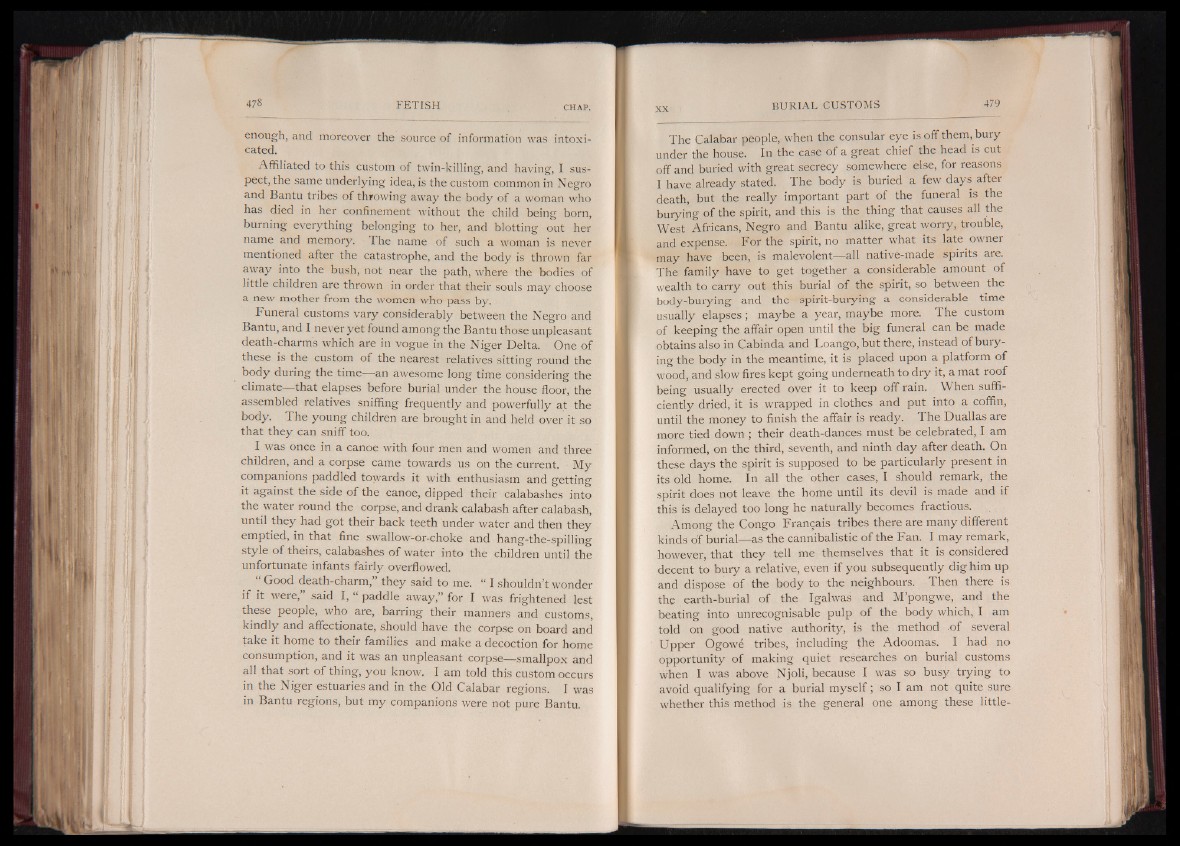
enough, and moreover the source of information was intoxicated.
Affiliated to this custom of twin-killing, and having, I suspect,
the same underlying idea, is the custom common in Negro
and Bantu tribes of throwing away the body of a woman who
has died in her confinement without the child being born,
burning everything belonging to her, and blotting out her
name and memory. The name of such a woman is never
mentioned after the catastrophe, and the body is thrown far
away into the bush, not near the path, where the bodies of
little children are thrown in order that their souls may choose
a new mother from the women who pass by.
Funeral customs vary considerably between the Negro and
Bantu, and I never yet found among the Bantu those unpleasant
death-charm's which are in vogue in the Niger Delta. One of
these is the custom of the nearest relatives sitting round the
body during the time— an awesome long time considering the
climate— that elapses before burial under the house floor, the
assembled relatives sniffing frequently and powerfully at the
body. The young children are brought in and held over it so
that they can sniff too.
I was once in a canoe with four men and women and three
children, and a corpse came towards us on the current. My
companions paddled towards it with enthusiasm and getting
it against the side of the canoe, dipped their calabashes into
the water round the corpse, and drank calabash after calabash,
until they had got their back teeth under water and then they
emptied, in that fine swallow-or-choke and hang-the-spilling
style of theirs, calabashes of water into the children until the
unfortunate infants fairly overflowed.
“ Good death-charm,” they said to me. “ I shouldn’t wonder
if it were, said I, “ paddle away,” for I was frightened lest
these people, who are, barring their manners and customs,
kindly and affectionate, should have the corpse on board and
take it home to their families and make a decoction for home
consumption, and it was an unpleasant corpse— smallpox and
all that sort of thing, you know. I am told this custom occurs
in the Niger estuaries and in the Old Calabar regions. I was
in Bantu regions, but my companions were not pure Bantu.
The Calabar people, when the consular eye is off them, bury
under the house. In the case of a great chief the head is cut
off and buried with great secrecy somewhere else, for reasons
I have already stated. The body is buried a few days after
death, but the really important part of the funeral is the
burying of the spirit, and this is the thing that causes all the
West Africans, Negro and Bantu alike, great worry, trouble,
and expense. For the spirit, no matter what its late owner
may have been, is malevolent— all native-made spirits are.
The family have to get together a considerable amount of
wealth to carry out this burial of the spirit, so between the
body-burying and the spirit-burying a considerable time
usually elapses ; maybe a year, maybe more. The custom
of keeping the affair open until the big funeral can be made
obtains also in Cabinda and Loango, but there, instead of burying
the body in the meantime, it is placed upon a platform of
wood, and slow fires kept going underneath to dry it, a mat roof
being usually erected over it to keep off rain. When sufficiently
dried, it is wrapped in clothes and put into a coffin,
until the money to finish the affair is ready. The Duallas are
more tied down ; their death-dances must be celebrated, I am
informed, on the third, seventh, and ninth day after death. On
these days the spirit is supposed to be particularly present in
its old home. In all the other cases, I should remark, the
spirit does not leave the home until its devil is made and if
this is delayed too long he naturally becomes fractious.
Among the Congo Français tribes there are many different
kinds of burial— as the cannibalistic of the Fan. I may remark,
however, that they tell me themselves that it is considered
decent to bury a relative, even if you subsequently dig him up
and dispose of the body to the neighbours. Then there is
the earth-burial of the Igalwas and M’pongwe, and the
beating into unrecognisable pulp of the body which, I am
told on good native authority, is the method of several
Upper Ogowé tribes, including the Adoomas. I had no
opportunity of making quiet researches on burial customs
when I was above Njoli, because I was so busy trying to
avoid qualifying for a burial myself ; so I am not quite sure
whether this method is the general one among these little